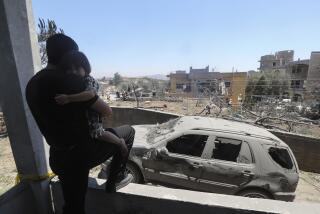The Eyes and Ears of War
- Share via
Stretched across a wall at the U.S. Air Force’s Combined Air Operations Center near the Persian Gulf is a shimmering, ever-changing display, showing the location of every aircraft above Iraq.
Throughout the war, commanders at the operations center used the map to reroute bombers the moment targets emerged -- whether they were Saddam Hussein sightings or Iraqi missile launches. In a matter of minutes -- not hours or days as in past wars -- commanders identified targets and then sent out orders to bomb.
This compression of time, known in the military as “shortening the kill chain,” was possible for just one reason: satellite information. Flowing through a network of electronic eyes and ears above Earth, information bathed the battlefield, sending location data to GPS units in tanks, messages to sturdy portable computers with the troops and satellite images to weather stations set up on the dusty front lines.
The fire hose of information from space was a little-heralded but critical part of the swift victory in Iraq, providing a different kind of shock and awe: the ability to act almost instantaneously and cripple the Iraqi army’s ability to respond.
In the Iraq war, space became the ultimate military high ground.
While last year’s conflict in Afghanistan saw the use of space technologies in small skirmishes, the Iraq war marked the first effort to apply them across an entire battlefield swarming with hundreds of thousands of soldiers and a constant rush of tanks, jets and helicopters.
“If you ask what was the difference between Iraq’s army and America’s army, the big difference was satellites,” said John Pike, a defense analyst with GlobalSecurity.org, an intelligence and military policy think tank based in Alexandria, Va. “And it’s technology you don’t even notice.”
Though overshadowed by headline-grabbing pilotless drones and 21,000-pound MOAB bunker-buster bombs, the quick, quiet, almost mundane flow of electronic information -- whether from polar orbiting weather satellites 23,000 miles above Earth or school bus-sized KH or “keyhole class” spy satellites keen enough to read large newspaper headlines from space -- proved one of the U.S. military’s most powerful weapons.
Big Changes
“Information is not just a weapon, it’s an enabling technology that changes the culture, institution and setting in which war is conducted. It changes everything,” said Loren Thompson, a defense and satellite expert at the Lexington Institute, a nonprofit think tank in Arlington, Va. “It is bringing about changes that are more fundamental than any we’ve ever seen before -- more fundamental than the tank, or the submarine, or even the atomic weapon.”
In the current war, about 90% of the allied bombs used were so-called smart bombs that were guided either with lasers or GPS signals from orbiting satellites, military officials said. In the 1991 Persian Gulf War, only about 10% of weapons were precision-guided.
For the first time, allied commanders at the front were able to receive on portable computers target images from orbiters such as the “Lacrosse” radar-imaging satellites, which can see through clouds and darkness. Weather satellites, both civilian and military, gave notice of advancing dust storms and clouds. A decade ago, images of crucial targets sometimes had to be hand-carried from as far away as Washington, or were slowly transmitted as blurry, barely legible faxes.
The time lag between a target’s identification and its destruction -- also known as the “sensor-to-shooter gap” -- has never been shorter. In an attempt to kill Hussein with an airstrike on April 7, “the time from when we identified the target to when we struck was less than 15 minutes,” said Col. Larry James, senior space officer at the air operations center.
Allen Thomson, a retired intelligence analyst now living in Texas, said the most important satellite assets in this war were “the unglamorous ones” that supported communications, navigation and meteorology. These include the military’s star performer: the Air Force Space Command’s behemoth “Milstar” satellites, 10,000-pound switchboards in space that provide secure voice and data communication around the world. The number of satellites of all types used in the war is estimated to be nearly 100.
While allied forces were flush with data coming in day and night, Iraqi officers appeared to be operating with very little good information, experts said. At times, the Iraqi leadership was sending orders to units that no longer existed.
“Our side knew where all of our forces were at any given moment and the other side did not,” said Steven Aftergood, a senior research analyst with the Federation of American Scientists. “It sounds simple, but it’s actually a significant technological achievement.”
Many allied tank commanders in forward positions were able to get a comprehensive picture of the fighting both nearby and across Iraq -- a real contrast from past tank warfare when a tank commander’s main job “was to figure out where the hell he was,” said the Lexington Institute’s Thompson.
Weather maps and data from the National Oceanographic and Atmospheric Administration’s two “POES,” or polar operational environmental satellites, were beamed down to antennas at forward battlefield locations four times a day.
“In the war theater, they can set up an antenna and receive this information as they go,” said Greg Whithee, who runs NOAA’s satellite program. “They can see dust storms, fires, brewing storms of all kinds and smoke plumes so they can give pilots real-time instructions.”
One reason satellites were so unheralded in the war was that their technology has become so common. Some of the most potent military tools are familiar to any office worker or teenager: instant messaging, video conferencing and wireless imaging. It’s not surprising that they worked well in war. After all, they were tested in the most ferocious battlefield of all: the consumer marketplace.
The father of “network-centric warfare” is Vice Adm. Arthur Cebrowski, a former F-14 jet pilot and battle group commander who directs the Pentagon’s Office of Force Transformation.
His inspiration for the heavily networked military of the 21st century? Wal-Mart Stores Inc. and its quilt of networked, synchronized operations.
Utilizing Commerce
In the past, the military created its own technologies -- including fax machines, the Internet and Humvees -- that were later spun off into the commercial market. In what experts now call “spin-on,” the military is making good use of commercially available technologies, such as satellite imaging, satellite phones and durable laptops, the same as those used by Sears, Roebuck and Co. repair workers.
“We don’t have to go out and build this all ourselves,” James said in a telephone interview from the operations center, which is located at an undisclosed site in southwest Asia. Many troops brought their own GPS units from home -- purchased for hunting, fishing or camping -- to use during battle, finding them lighter and easier to use than the rugged, jam-proof military versions.
The contrast couldn’t have been greater to James, who spent much of the 1991 Gulf War at the Pentagon trying to get a relatively small number of GPS units into the desert. “People called that the first space war, but we were just in our infancy,” said James, who is usually based at the Air Force Space Command in Colorado Springs. “We’ve moved light years ahead.”
The information-based strategy, which allows for the use of less force, is one possible reason the commander of allied forces in Iraq, Army Gen. Tommy Franks, felt confident entering the war with fewer troops than were deployed in 1991.
As the amount of information rises in war, the amount of weaponry needed falls, said Bruce Berkowitz, a research fellow at Stanford University’s Hoover Institute and the author of “The New Face of War.” While it took 648 bombs, on average, to hit a single target in World War II, military leaders of this war could hit a target with one GPS-guided bomb.
“In some cases, there is no explosive charge at all,” Berkowitz said, citing the use of laser-guided “inert bombs” -- filled only with concrete that can destroy small targets using kinetic energy alone. “A little information goes a long way.”
The number of eyes in space is only set to increase. Twelve “national security” launches are slated for 2003, compared to just one last year.
Worries Arise
The increasing reliance on the information flow, however, is raising some concerns. The speed of transmitting information and the automation of weapons systems have created the potential for a problems that can arise faster than humans can correct them. The Pentagon, for example, is analyzing the “automatic engagement mode” of the Patriot antimissile system, which shot down two friendly aircraft and targeted a third during the Iraq fighting.
Others are concerned about what could happen to an information-reliant army if information stopped flowing.
The deaths of seven U.S. servicemen on a frigid mountaintop in Afghanistan on March 4 last year has been blamed, in part, on such a breakdown. The soldiers’ Chinook helicopter was ambushed during an attempt to rescue a Navy SEAL. Voice communications failed between the team, their commanders at Bagram air base and the U.S. forces fighting nearby. The rescue team did not receive information that U.S. forces had retreated from the area, and they walked into an enemy ambush.
“As warriors become more dependent on the network, they become increasingly vulnerable to its loss,” Thompson said.
Electronic resources also are vulnerable to relatively low-tech jamming technologies. Low-flying satellites can be destroyed by missile strikes. High fliers could be targeted by nuclear weapons, which can fry electronic circuits with a burst of electromagnetic radiation when detonated.
The other danger is that the technology that gives the U.S. military such an edge against massed armies will ultimately drive enemies to adopt strategies that are less vulnerable, such as individual terrorist bombings and suicide attacks.
And the ubiquity and low cost of electronics that has been so helpful to the United States military will inevitably serve the country’s enemies as well, Berkowitz said.
“Al Qaeda was able to buy a secure command and control system -- satellite phones and encrypted Internet -- off the shelf,” he said.
More to Read
Sign up for Essential California
The most important California stories and recommendations in your inbox every morning.
You may occasionally receive promotional content from the Los Angeles Times.










